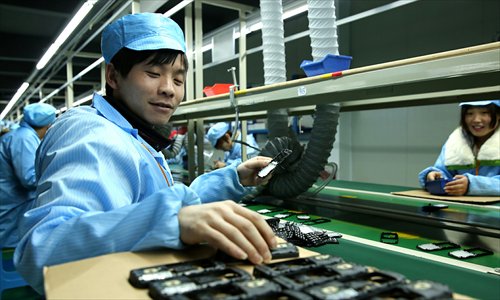HOME >> BUSINESS
Growth does not have to reach 7%: minister
By Liang Fei Source:Global Times Published: 2015-6-24 23:13:01
More easing policies expected to boost economy

A worker assembles electric products at a factory in Huaying, Southwest China's Sichuan Province. Photo: IC
China's GDP growth does not have to reach 7 percent this year, financial news portal wallstreetcn.com reported Wednesday citing Finance Minister Lou Jiwei, who also said that the current growth is "within a reasonable range."
Lou made the remarks during a press briefing at the seventh China-US Strategic and Economic Dialogue (S&ED), which was held in Washington DC from Tuesday to Wednesday.
Lou emphasized at the press briefing that the GDP growth target this year is "around 7 percent," adding that GDP is not the only indicator for growth. Lou noted that structural improvements and stable employment are also crucial, news portal thepaper.cn reported Wednesday.
He also said at the S&ED that quantitative easing and fiscal measures are only short-term remedies for the economy, and that structural reform is the fundamental way to realize sustainable growth, the official Xinhua News Agency reported Wednesday.
Lu Ting, chief economist at Huatai Securities, noted that Lou's remarks should not be considered as a sign that the central government will stop rolling out more easing and supportive measures, given the persistent downward pressure on the economy.
"Without further easing, it will be hard for GDP growth to even reach the target of 'around 7 percent,'" Lu told the Global Times Wednesday.
China's GDP growth slowed to a six-year low of 7 percent in the first quarter and some economists predict that the rate may further dip to 6.8 percent in the second quarter.
Experts have been divided on the prospects for further monetary easing, with some saying it will come soon and others believing the likelihood of further easing is decreasing given the improvement in some economic indicators, such as power consumption and housing prices.
Power consumption, a major indicator of industrial vitality, grew by 1.3 percent in April, rebounding from declines in February and March and the growth further increased to 1.6 percent in May, data from the National Energy Administration showed.
The improvement in these indicators points to a possible upward trend in the economy, though it is still uncertain whether this upward trend will continue, Liu Xuezhi, an analyst with Bank of Communications, told the Global Times Wednesday.
Whether or not more monetary easing is coming "depends on economic performance in the second quarter," Liu said, adding that if GDP growth for the quarter comes in well below 7 percent, more easing will soon follow.
Meanwhile, Zhou Xiaochuan, governor of the People's Bank of China (PBC), the central bank, declined to comment on the possibility of further interest rate cuts at the S&ED, wallstreetcn.com reported Wednesday.
Experts noted that it will be a challenging task for China to reach GDP growth of 7 percent this year. The PBC has already cut interest rates three times and lowered banks' reserve requirement ratio (RRR) twice since November 2014.
"I think that more monetary easing is expected in the second half, especially more RRR cuts, to counter the negative effects brought about by capital outflows," said Lu of Huatai Securities.
Official data shows that China is currently facing growing pressure from capital outflows. In April, funds outstanding for foreign exchange dropped 45.94 billion yuan ($7.4 billion) to 26.77 trillion yuan, the third consecutive monthly drop, according to PBC data earlier this month.
The US Federal Reserve may raise interest rates in September this year, media reports said, raising concerns that this could cause further capital outflows from developing economies.
But Lou dismissed the concerns at the S&ED, saying that a possible interest rate hike in the US will have a limited impact and will not cause massive capital outflows from China, wallstreetcn.com reported.
Posted in: Economy